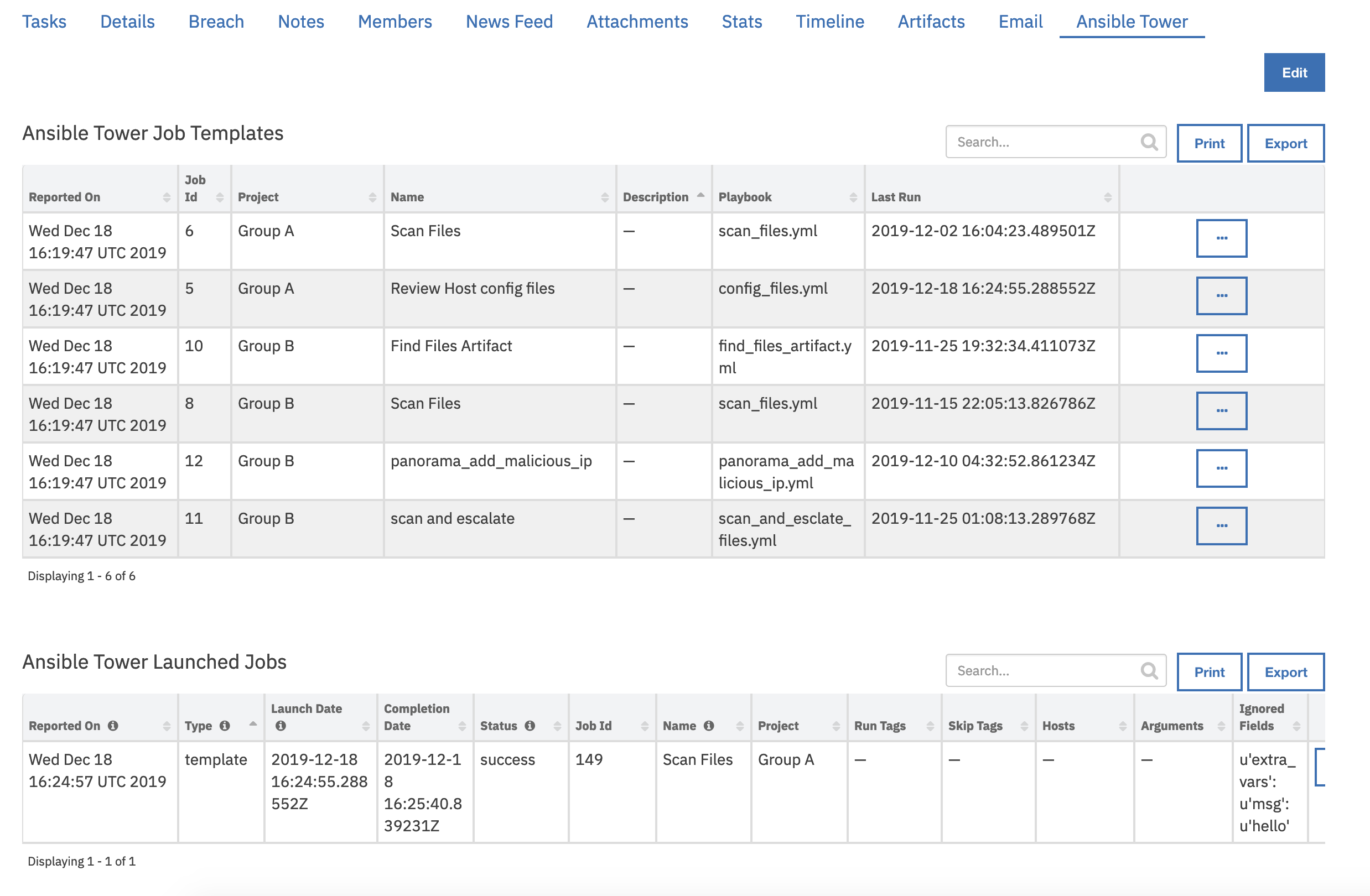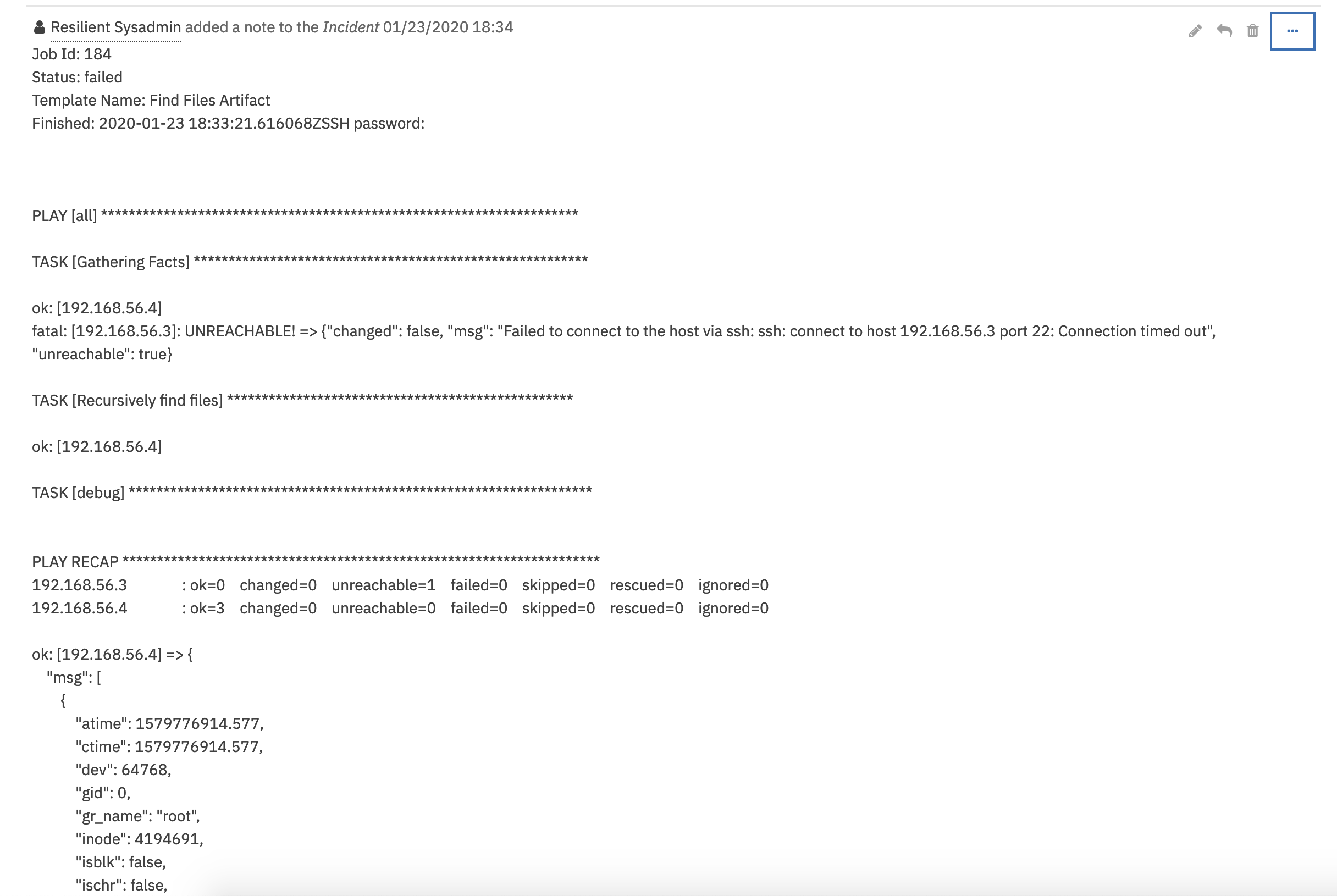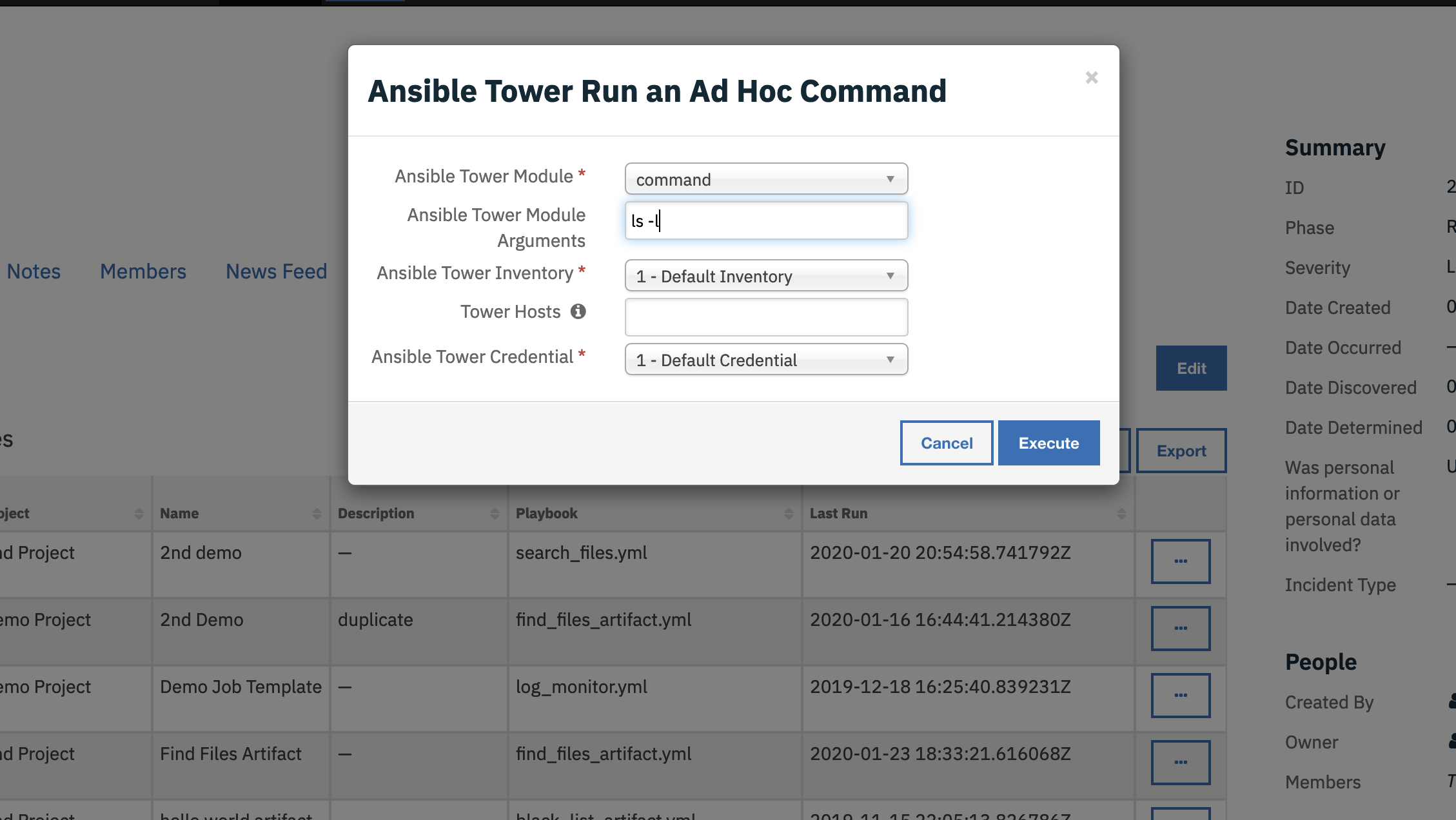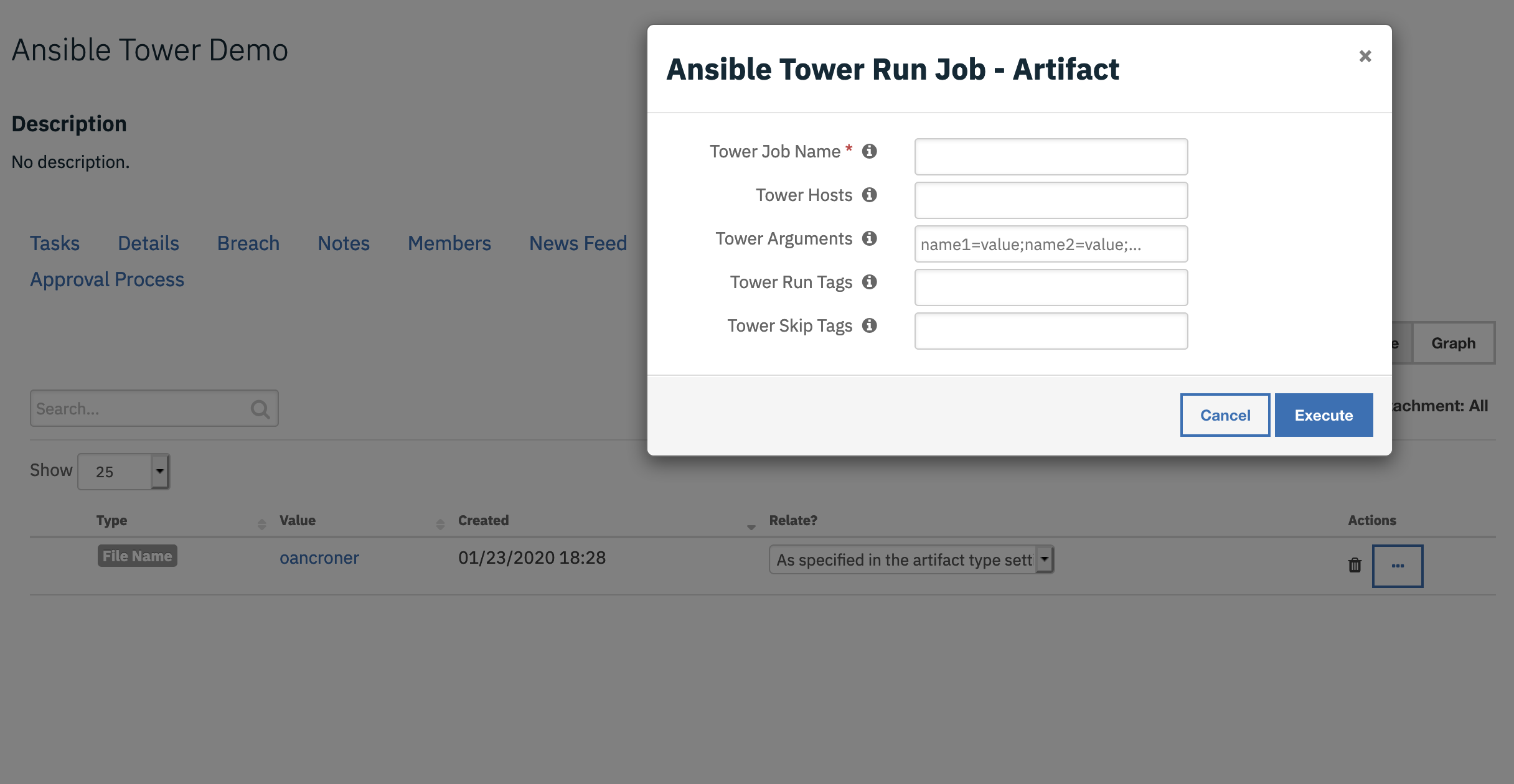Ansible Tower¶
Table of Contents¶
Release Notes¶
Release |
Date |
Notes |
|---|---|---|
v1.0.4 |
10/2024 |
Rebuilt the app to server v51.0.0 |
v1.0.3 |
7/2021 |
Bug fix to handle results data |
v1.0.2 |
2/2021 |
Bug fix for paged results from templates, jobs, etc. |
v1.0.1 |
12/2020 |
App Host support |
v1.0.0 |
2/2020 |
Initial release |
Overview¶
Resilient Circuits Components for ‘fn_ansible_tower’
This integration provides the capability to execute jobs and return job results from Ansible Tower.
Specific features include:
List Job Templates filtering by Project
Execute Job Templates, specifying name/value pairs for job template substitution
Execute ad-hoc Jobs, specifying name/value pairs for module parameters
List Jobs run filtered by status or date
Return Job run results

Requirements¶
This app supports the IBM Security QRadar SOAR Platform and the IBM Security QRadar SOAR for IBM Cloud Pak for Security.
SOAR platform¶
The SOAR platform supports two app deployment mechanisms, Edge Gateway (also known as App Host) and integration server.
If deploying to a SOAR platform with an App Host, the requirements are:
SOAR platform >=
51.0.0.The app is in a container-based format (available from the AppExchange as a
zipfile).
If deploying to a SOAR platform with an integration server, the requirements are:
SOAR platform >=
51.0.0.The app is in the older integration format (available from the AppExchange as a
zipfile which contains atar.gzfile).Integration server is running
resilient_circuits>=51.0.0.If using an API key account, make sure the account provides the following minimum permissions:
Name
Permissions
Org Data
Read
Function
Read
The following SOAR platform guides provide additional information:
Edge Gateway Deployment Guide or App Host Deployment Guide: provides installation, configuration, and troubleshooting information, including proxy server settings.
Integration Server Guide: provides installation, configuration, and troubleshooting information, including proxy server settings.
System Administrator Guide: provides the procedure to install, configure and deploy apps.
The above guides are available on the IBM Documentation website at ibm.biz/soar-docs. On this web page, select your SOAR platform version. On the follow-on page, you can find the Edge Gateway Deployment Guide, App Host Deployment Guide, or Integration Server Guide by expanding Apps in the Table of Contents pane. The System Administrator Guide is available by expanding System Administrator.
Cloud Pak for Security¶
If you are deploying to IBM Cloud Pak for Security, the requirements are:
IBM Cloud Pak for Security >=
1.10.16.Cloud Pak is configured with an Edge Gateway.
The app is in a container-based format (available from the AppExchange as a
zipfile).
The following Cloud Pak guides provide additional information:
Edge Gateway Deployment Guide or App Host Deployment Guide: provides installation, configuration, and troubleshooting information, including proxy server settings. From the Table of Contents, select Case Management and Orchestration & Automation > Orchestration and Automation Apps.
System Administrator Guide: provides information to install, configure, and deploy apps. From the IBM Cloud Pak for Security IBM Documentation table of contents, select Case Management and Orchestration & Automation > System administrator.
These guides are available on the IBM Documentation website at ibm.biz/cp4s-docs. From this web page, select your IBM Cloud Pak for Security version. From the version-specific IBM Documentation page, select Case Management and Orchestration & Automation.
Proxy Server¶
The app does support a proxy server.
Python Environment¶
Python 3.9, 3.11, and 3.12 are officially supported. When deployed as an app, the app runs on Python 3.11. Additional package dependencies may exist for each of these packages:
resilient_circuits>=51.0.0
resilient_lib>=51.0.0
Installation¶
Install¶
To install or uninstall an App or Integration on the SOAR platform, see the documentation at ibm.biz/soar-docs.
To install or uninstall an App on IBM Cloud Pak for Security, see the documentation at ibm.biz/cp4s-docs and follow the instructions above to navigate to Orchestration and Automation.
App Configuration¶
The following table provides the settings you need to configure the app. These settings are made in the app.config file. See the documentation discussed in the Requirements section for the procedure.
Config |
Required |
Example |
Description |
|---|---|---|---|
username |
Yes |
`` |
User name for API access to Ansible Tower |
password |
Yes |
`` |
Password for above user name |
url |
Yes |
`` |
URL to Ansible Tower |
cafile |
Yes |
|
False for no SSL certificate verification or path to certificate file |
Integration Server¶
Download the
app-fn_ansible_tower-x.x.x.zip.Copy the
.zipto your Integration Server and SSH into it.Unzip the package:
$ unzip app-fn_ansible_tower-x.x.x.zip
Install the package:
$ pip install fn_ansible_tower-x.x.x.tar.gz
Import the configurations into your app.config file:
$ resilient-circuits config -u
Import the fn_ansible_tower customizations into the Resilient platform:
$ resilient-circuits customize -y -l fn-ansible-tower
Open the config file, scroll to the bottom and edit your fn_ansible_tower configurations:
$ nano ~/.resilient/app.config
Config
Required
Example
Description
username
Yes
``
User name for API access to Ansible Tower
password
Yes
``
Password for above user name
url
Yes
``
URL to Ansible Tower
cafile
Yes
FalseFalse for no SSL certificate verification or path to certificate file
Save and Close the app.config file.
[Optional]: Run selftest to test the Integration you configured:
$ resilient-circuits selftest -l fn-ansible-tower
Run resilient-circuits or restart the Service on Windows/Linux:
$ resilient-circuits run
Custom Layouts¶
Import the Data Tables like the screenshot below:

Uninstall¶
SSH into your Integration Server.
Uninstall the package:
$ pip uninstall fn-ansible-tower
Open the config file, scroll to the [fn_ansible_tower] section and remove the section or prefix
#to comment out the section.Save and Close the app.config file.
Function - Ansible Tower Get Ad Hoc Command Results¶
Return the results of an ad hoc command job

Inputs:
Name |
Type |
Required |
Example |
Tooltip |
|---|---|---|---|---|
|
|
Yes |
|
- |
|
|
Yes |
|
Launched job Id for a job template |
|
|
Yes |
|
- |
Outputs:
NOTE: This example might be in JSON format, but
resultsis a Python Dictionary on the SOAR platform.
results = {
# TODO: Generate an example of the Function Output within this code block.
# To get the output of a Function:
# 1. Run resilient-circuits in DEBUG mode: $ resilient-circuits run --loglevel=DEBUG
# 2. Invoke the Function in SOAR
# 3. Gather the results using: $ resilient-sdk codegen -p fn_ansible_tower --gather-results
# 4. Run docgen again: $ resilient-sdk docgen -p fn_ansible_tower
# Or simply paste example outputs manually here. Be sure to remove any personal information
}
Example Function Input Script:
inputs.tower_job_id = row['job_id']
inputs.tower_save_as = rule.properties.tower_save_as
inputs.incident_id = incident.id
Example Function Post Process Script:
import re
if results.content:
finished = results.content['summary']['finished'].replace('T', ' ') if results.content['summary']['finished'] else None
row['status'] = results.content['summary']['status']
row['completion_date'] = finished
note = u"Job Id: {}\nStatus: {}\nTemplate Name: {}\nFinished: {}".format(results.inputs['tower_job_id'], results.content['summary']['status'],
results.content['summary']['name'], finished)
if not results.inputs['tower_save_as_attachment']:
note = note + u"\n".join(event.get("stdout") for event in results.content['events']['results'])
incident.addNote(re.sub(r'[\x00-\x7f]\[[0-9;]*m', r'', note)) # remove color hilighting
else:
attachment_name = u"{}_{}.txt".format(results.content['summary']['name'].replace(" ", "_"), results.inputs['tower_job_id'])
note = note + u"\nAttachment Name: {}".format(attachment_name)
incident.addNote(note)
Function - Ansible Tower Get Job Results¶
Get the results of a complete job

Inputs:
Name |
Type |
Required |
Example |
Tooltip |
|---|---|---|---|---|
|
|
Yes |
|
- |
|
|
Yes |
|
Launched job Id for a job template |
|
|
Yes |
|
- |
Outputs:
NOTE: This example might be in JSON format, but
resultsis a Python Dictionary on the SOAR platform.
results = {
# TODO: Generate an example of the Function Output within this code block.
# To get the output of a Function:
# 1. Run resilient-circuits in DEBUG mode: $ resilient-circuits run --loglevel=DEBUG
# 2. Invoke the Function in SOAR
# 3. Gather the results using: $ resilient-sdk codegen -p fn_ansible_tower --gather-results
# 4. Run docgen again: $ resilient-sdk docgen -p fn_ansible_tower
# Or simply paste example outputs manually here. Be sure to remove any personal information
}
Example Function Input Script:
inputs.tower_job_id = row['job_id']
inputs.tower_save_as = rule.properties.tower_save_as
inputs.incident_id = incident.id
Example Function Post Process Script:
import re
if results.content:
finished = results.content['summary']['finished'].replace('T', ' ') if results.content['summary']['finished'] else None
row['status'] = results.content['summary']['status']
row['completion_date'] = finished
note = u"Job Id: {}\nStatus: {}\nTemplate Name: {}\nFinished: {}".format(results.inputs['tower_job_id'], results.content['summary']['status'],
results.content['summary']['name'], finished)
if not results.inputs['tower_save_as_attachment']:
note = note + u"\n".join(event.get("stdout") for event in results.content['events']['results'])
incident.addNote(re.sub(r'[\x00-\x7f]\[[0-9;]*m', r'', note)) # remove color hilighting
else:
attachment_name = u"{}_{}.txt".format(results.content['summary']['name'].replace(" ", "_"), results.inputs['tower_job_id'])
note = note + u"\nAttachment Name: {}".format(attachment_name)
incident.addNote(note)
Function - Ansible Tower List Job Templates¶
List available job templates. * Wildcard can be used to filter project and template names

Inputs:
Name |
Type |
Required |
Example |
Tooltip |
|---|---|---|---|---|
|
|
No |
|
Optionally filter by project. Supports * wildcard |
|
|
No |
|
Use * to use wildcard matches |
Outputs:
NOTE: This example might be in JSON format, but
resultsis a Python Dictionary on the SOAR platform.
results = {
# TODO: Generate an example of the Function Output within this code block.
# To get the output of a Function:
# 1. Run resilient-circuits in DEBUG mode: $ resilient-circuits run --loglevel=DEBUG
# 2. Invoke the Function in SOAR
# 3. Gather the results using: $ resilient-sdk codegen -p fn_ansible_tower --gather-results
# 4. Run docgen again: $ resilient-sdk docgen -p fn_ansible_tower
# Or simply paste example outputs manually here. Be sure to remove any personal information
}
Example Function Input Script:
inputs.tower_project = rule.properties.tower_project
inputs.tower_template_pattern = rule.properties.tower_template_pattern
Example Function Post Process Script:
import java.util.Date as Date
if not results.content:
row = incident.addRow("ansible_tower_job_templates")
row['reported_on'] = str(Date())
row['template_name'] = "-- No results returned --"
else:
for template in results.content:
row = incident.addRow("ansible_tower_job_templates")
row['reported_on'] = str(Date())
row['template_id'] = template['id']
row['template_name'] = template['name']
row['template_description'] = template['description']
row['template_project'] = template['summary_fields']['project']['name']
row['template_playbook'] = template['playbook']
row['template_last_run'] = template['last_job_run'].replace('T', ' ') if template['last_job_run'] else None
Function - Ansible Tower List Jobs¶
List Ansible Tower jobs based on job status and last modified conditions

Inputs:
Name |
Type |
Required |
Example |
Tooltip |
|---|---|---|---|---|
|
|
No |
|
Leave empty for all status values |
|
|
No |
|
specify timeframe to filter returned jobs |
Outputs:
NOTE: This example might be in JSON format, but
resultsis a Python Dictionary on the SOAR platform.
results = {
# TODO: Generate an example of the Function Output within this code block.
# To get the output of a Function:
# 1. Run resilient-circuits in DEBUG mode: $ resilient-circuits run --loglevel=DEBUG
# 2. Invoke the Function in SOAR
# 3. Gather the results using: $ resilient-sdk codegen -p fn_ansible_tower --gather-results
# 4. Run docgen again: $ resilient-sdk docgen -p fn_ansible_tower
# Or simply paste example outputs manually here. Be sure to remove any personal information
}
Example Function Input Script:
inputs.tower_job_status = rule.properties.job_status
inputs.tower_last_updated = rule.properties.last_updated
Example Function Post Process Script:
import java.util.Date as Date
for job in results.content:
run_row = incident.addRow('ansible_tower_launched_jobs')
run_row['reported_on'] = str(Date())
run_row['type'] = 'template'
run_row['launch_date'] = job['created'].replace('T', ' ')
run_row['status'] = job['status']
run_row['job_id'] = job['id']
run_row['template_name'] = job['name']
run_row['project'] = job['summary_fields']['project']['name']
run_row['run_tags'] = job['job_tags']
run_row['skip_tags'] = job['skip_tags']
run_row['inventory'] = job['limit']
run_row['arguments'] = job['extra_vars'].replace("{", "").replace("}", "")
#run_row['ignored_fields'] = str(job['ignored_fields'])
Function - Ansible Tower Run an Ad Hoc Command¶
Run an ad hoc command through ansible tower

Inputs:
Name |
Type |
Required |
Example |
Tooltip |
|---|---|---|---|---|
|
|
No |
|
Semicolon separated name/value pairs |
|
|
Yes |
|
- |
|
|
No |
|
comma separated list of hosts to limit |
|
|
No |
|
- |
|
|
No |
|
- |
Outputs:
NOTE: This example might be in JSON format, but
resultsis a Python Dictionary on the SOAR platform.
results = {
# TODO: Generate an example of the Function Output within this code block.
# To get the output of a Function:
# 1. Run resilient-circuits in DEBUG mode: $ resilient-circuits run --loglevel=DEBUG
# 2. Invoke the Function in SOAR
# 3. Gather the results using: $ resilient-sdk codegen -p fn_ansible_tower --gather-results
# 4. Run docgen again: $ resilient-sdk docgen -p fn_ansible_tower
# Or simply paste example outputs manually here. Be sure to remove any personal information
}
Example Function Input Script:
inputs.tower_module = rule.properties.ansible_tower_module
inputs.tower_arguments = rule.properties.ansible_tower_module_arguments
inputs.tower_hosts = rule.properties.ansible_tower_hosts
inventory = rule.properties.ansible_tower_inventory
if inventory.find('-') != -1:
inv_split = inventory.split("-")
else:
inv_split = inventory.split(" ")
inputs.tower_inventory = int(inv_split[0])
credential = rule.properties.ansible_tower_credential
if credential.find('-') != -1:
cred_split = credential.split("-")
else:
cred_split = credential.split(" ")
inputs.tower_credential = int(cred_split[0])
Example Function Post Process Script:
import java.util.Date as Date
run_row = incident.addRow('ansible_tower_launched_jobs')
run_row["reported_on"] = str(Date())
run_row['type'] = 'ad hoc'
run_row['launch_date'] = results.content['created'].replace('T', ' ')
run_row['status'] = results.content['status']
run_row['job_id'] = results.content['id']
run_row['template_name'] = results.content['name']
run_row['inventory'] = results.content['limit']
run_row['arguments'] = str(results.content['module_args']).replace("{", "").replace("}", "")
Function - Ansible Tower Run Job¶
Execute a job for a given tower template

Inputs:
Name |
Type |
Required |
Example |
Tooltip |
|---|---|---|---|---|
|
|
No |
|
Semicolon separated name/value pairs |
|
|
No |
|
comma separated list of hosts to limit |
|
|
No |
|
Comma separated list of plays to run |
|
|
No |
|
Comma separated list of plays to skip |
|
|
No |
|
Job Template Id to launch |
|
|
No |
|
Name of Job Template, optional to tower_template_id |
Outputs:
NOTE: This example might be in JSON format, but
resultsis a Python Dictionary on the SOAR platform.
results = {
# TODO: Generate an example of the Function Output within this code block.
# To get the output of a Function:
# 1. Run resilient-circuits in DEBUG mode: $ resilient-circuits run --loglevel=DEBUG
# 2. Invoke the Function in SOAR
# 3. Gather the results using: $ resilient-sdk codegen -p fn_ansible_tower --gather-results
# 4. Run docgen again: $ resilient-sdk docgen -p fn_ansible_tower
# Or simply paste example outputs manually here. Be sure to remove any personal information
}
Example Function Input Script:
inputs.tower_template_name = rule.properties.ansible_tower_job_name
inputs.tower_hosts = rule.properties.ansible_tower_hosts
artifact_data = "artifact_value={};artifact_type={}".format(artifact.value, artifact.type)
if rule.properties.ansible_tower_arguments:
inputs.tower_arguments = ";".join((rule.properties.ansible_tower_arguments, artifact_data))
else:
inputs.tower_arguments = artifact_data
inputs.tower_run_tags = rule.properties.ansible_tower_run_tags
inputs.tower_skip_tags = rule.properties.ansible_tower_skip_tags
Example Function Post Process Script:
import java.util.Date as Date
if not results.content['failed']:
run_row = incident.addRow('ansible_tower_launched_jobs')
run_row['reported_on'] = str(Date())
run_row['type'] = 'template'
run_row['launch_date'] = results.content['created'].replace('T', ' ')
run_row['status'] = results.content['status']
run_row['job_id'] = results.content['job']
run_row['template_name'] = results.content['name']
run_row['project'] = results.content['summary_fields']['project']['name']
run_row['run_tags'] = results.content['job_tags']
run_row['skip_tags'] = results.content['skip_tags']
run_row['inventory'] = results.content['limit']
run_row['arguments'] = str(results.content['extra_vars']).replace("{", "").replace("}", "")
run_row['ignored_fields'] = str(results.content['ignored_fields']).replace("{", "").replace("}", "")
Custom Layouts¶
Import the Data Tables and Custom Fields like the screenshot below:

Data Table - Ansible Tower Job Templates¶

API Name:¶
ansible_tower_job_templates
Columns:¶
Column Name |
API Access Name |
Type |
Tooltip |
|---|---|---|---|
Description |
|
|
- |
Job Id |
|
|
- |
Last Run |
|
|
- |
Name |
|
|
- |
Playbook |
|
|
- |
Project |
|
|
- |
Reported On |
|
|
- |
Data Table - Ansible Tower Launched Jobs¶

API Name:¶
ansible_tower_launched_jobs
Columns:¶
Column Name |
API Access Name |
Type |
Tooltip |
|---|---|---|---|
Arguments |
|
|
- |
Completion Date |
|
|
- |
Hosts |
|
|
- |
Ignored Fields |
|
|
- |
Job Id |
|
|
- |
Launch Date |
|
|
Date Job was created |
Name |
|
|
Job Template Name |
Project |
|
|
- |
Reported On |
|
|
Date row was added |
Run Tags |
|
|
- |
Skip Tags |
|
|
- |
Status |
|
|
Status of Job |
Type |
|
|
‘ad hoc’, ‘template’ |
Rules¶
Rule Name |
Object |
Workflow Triggered |
Condition |
|---|---|---|---|
Ansible Tower Get Ad Hoc Command Results |
ansible_tower_launched_jobs |
|
|
Ansible Tower Get Job Results |
ansible_tower_launched_jobs |
|
|
Ansible Tower List Job Templates |
incident |
|
|
Ansible Tower List Jobs |
incident |
|
|
Ansible Tower Run an Ad Hoc Command |
incident |
|
|
Ansible Tower Run Job |
ansible_tower_job_templates |
|
|
Ansible Tower Run Job - Artifact |
artifact |
|
|
Ansible Tower Run Job - Incident |
incident |
|
|
Troubleshooting & Support¶
Refer to the documentation listed in the Requirements section for troubleshooting information.
For Support¶
This is a IBM Community provided app. Please search the Community ibm.biz/soarsupport for assistance.